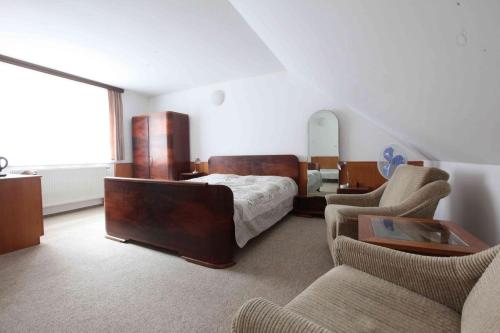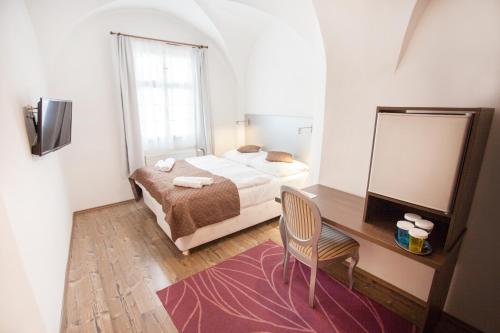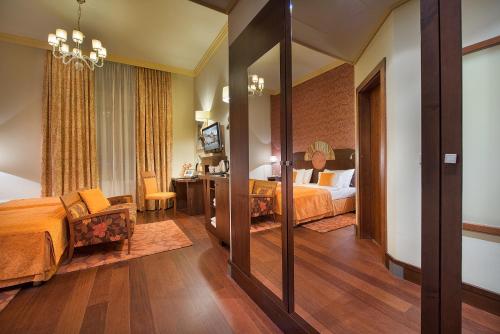Holašovice, Czech Republic
It’s quiet here. Really quiet. The public bus I arrived on is rumbling down the road away from me.
I was the only passenger who got off here and I’m standing by the side of the road alone. The engine of the bus is the only sound and now it’s almost gone.
I’ve come out to the small village of Holašovice, near the large urban centre of Česke Budejovice. It seems like a world away from the activity of the big city I’ve just come from.
No shopping centres or market squares, no large hotels or industrial parks. In fact, Holašovice only has 23 houses in its centre. But they are why I’m here.
This small community is a perfect representation of the traditional villages that used to dot the countryside of Central Europe. Most of them – almost all of them, in fact – have now disappeared.
Holašovice is one of the few that remain and the only one that hasn’t been dramatically changed. It’s why UNESCO has included it on the World Heritage List.
Holašovice has been quiet before – and it’s one of the reasons it still has the appearance of centuries ago.
After the Second World War, it was abandoned and stood deserted under the communist regime. It wasn’t until 1990 that people started moving in to the buildings again and restoring them.
The population grew until it reached the 140 people who live here today.
The 23 houses are all placed around a central square with a pond and a community building in the middle. Effectively, there is just one street in the village that forms a vague rectangle shape, about 200 metres long and 50 metres wide.
The houses might better be described as ‘farmyards’ because that’s effectively what they are. Most of them have an entrance gate that leads to a yard behind the front wall.
If you continued further back, past the main buildings, you would reach a small plot of land that was once used for farming. The larger homesteads tend to have things like granaries on the site as well.
For visitors, the first thing you see is the facades of these farms. They were generally built during a period from the early nineteenth century and are colourful with white stucco ornamentation.
Each is different, with its own individual design. But consistent elements across each of them create a continuous artwork, like a mural with a 360 degree perspective.
The ground plan of Holašovice may be from the Middle Ages but these decorations place the village in a particular period of time, in the nineteenth and early twentieth century when farmers were coming out from under the control of lords and they had more money to spend on aesthetics.
It created a new style known as South Bohemian Folk Baroque.
As I walk around, looking at the buildings, popping inside one to order a coffee, taking photos, the grassy square in the middle has become busier.
I must have beaten the tourist rush because there are now several dozen people also walking around and looking at the village.
It’s certainly not crowded – this part of the Czech Republic is not nearly as popular as Prague – but my declaration that Holašovice was quiet seems slightly premature.
I don’t think these new arrivals will stay long. Having said that, neither will I. There is not a lot to see or do here other than the obvious.
That’s not a problem – in fact, it’s quite nice. There are no artificial attractions to cater to tourists.
Holašovice is not an open air museum, it is a real village where people live and work.
It could easily have continued its fall into disrepair after World War II but it has been saved and, for those of us who are interested in cultural heritage, that is very pleasing to see.
Where is Holašovice village?
The village is about 18 kilometres west of the city of Česke Budejovice. You can see it on a map here.
How do you get to Holašovice village?
It takes about 25 minutes to drive from Česke Budejovice to Holašovice.
There are also buses that take about 40 minutes. The bus leaves from the roof of the Mercury Shopping Centre (opposite the main railway station). You can find the current timetable here.
When is Holašovice open?
The village is a public area so technically it is open all the time. The small businesses all keep their own hours but are open most of the time. The information centre is open Saturday and Sunday from 09:00 – 17:00 from April to October, and Monday to Friday from November to December. It is closed from January to March.
How much does it cost to visit Holašovice?
The village is a public area so it is free to visit and walk around.
I found there was a bus that left Česke Budejovice at 11:00 and arrived at 11:40. It then came back through Holašovice at 12:50. For me, an hour was long enough to see the village, take a bunch of photos and have a coffee.
I would recommend staying overnight in Česke Budejovice if you’re not in a rush. The historic centre of the city is beautiful and nice for a meal. You can also visit the Budweiser Brewery.
THE BEST ACCOMMODATION IN ČESKÉ BUDEJOVICE
It’s a small city and you should be able to find something nice in the historic centre or walking distance from the train station..
BACKPACKER
If you’re looking for a budget option, I would suggest Cuba Bar and Hostel in the centre of the city.
BUDGET

For something a bit local, Hotel Bohemia is a good option because it has a popular beer garden on site.
BOUTIQUE

For a cool and stylish option, you should try U Tří Hrušek Suites & Apartments.
LUXURY

And if you’re after a bit of luxury, have a look at Zvon Design Suites.
Wow, this Czech village is lovely. The photos and descriptions make it seem more beautiful, Michael.
It’s so cute, isn’t it? And I can’t believe how well it has been protected.
Wow! Czech is simple yet so beautiful.What an amazing place to visit. Thanks for sharing mate. Very well written and superbly photographed.
Thanks, Alex. Yeah – it’s a really beautiful country and there’s so much to discover. I definitely didn’t know about all of this before I went.
Bet you wouldn’t have visited if it wasn’t on the list, would you? 😉
Well, I wouldn’t have known to visit it is probably the point. I love trying to see all the World Heritage Sites because it takes me to places like this. Would I have gone if I had known about it but it wasn’t on the list… possibly, possibly not. I probably wouldn’t have gone out of my way but I would have visited if I had been nearby and hadn’t seen anything else quite like it yet. WHS’s aren’t the only things I do and I always enjoy going a little off the beaten track.
This village was 100 % German before WWII.
And btw it’s Czechia since more than one year http://google-maps.pro/Czechia